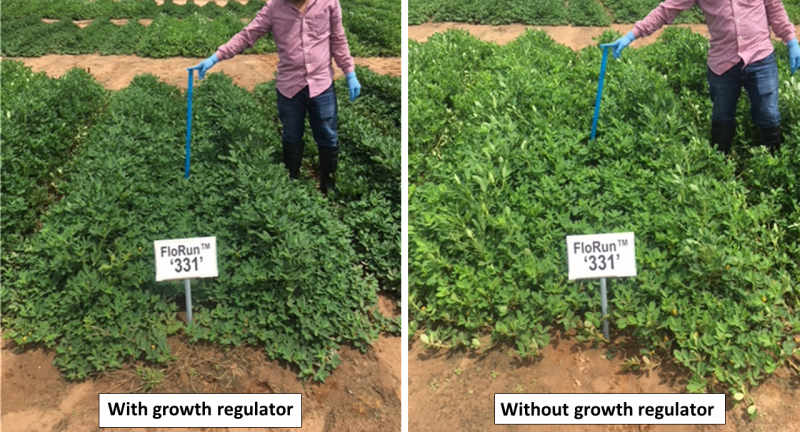Barry Tillman, UF/IFAS Peanut Breeder, and Scott Monfort, UGA Extension Peanut Agronomist
Excessive peanut vine growth can be problematic in several ways. First, too much vine can increase disease because of the ability of the canopy to hold moisture and the inability of fungicides to penetrate the dense canopy. Second, excessive vine growth can slow harvest operations, costing time and money. And finally, damaged vines during mid-season pesticide applications can increase disease and yield losses.
Appropriate use of the growth regulators Apogee or Kudos (prohexadione calcium) can help to manage vine growth and increase yield. A recent article in Peanut Science (Studstill et al., 2020; Influence of Prohexadione Calcium Rate on Growth and Yield of Peanut) showed that the growth of peanut was reduced by growth regulator application AND that the pod yield of runner-type varieties was increased in farm-scale studies in Georgia and Mississippi. Using the 0.75X rate (5.4 oz/acre Apogee) reduced the plant height by about 4 inches and increased yield by about 700 pounds per acre, translating to about $85 per acre net return. It is important to note that yield increase is not guaranteed, due to specific conditions in each field and season, but on average, the treatment pays for itself or makes money. The Apogee label specifies that peanut should be actively growing and without stress from disease or drought when the application is made. The first application should occur when 50% of the stems are touching in the row middles (not before) and a second application 14 days later.

Comparison of FloRun 331 treated with a growth regulator (left) versus untreated (right). Credit: Barry Tillman, UF/IFAS
–
After talking with the lead author of the study, Dr. Scott Monfort, University of Georgia Extension Peanut Specialist, here are a few practical tips for using this growth regulator:
- Timing is very important. Apply the first time when the row middles have reached full lapping – usually around 60-65 days after planting. It is better to be a little late on the first application than too early, because it might prevent lapping altogether.
- Apply the second dose about 14 days later.
- A rate of 4-5.4 ounces of product per acre is sufficient for most runner type peanuts.
- The addition of ammonium sulfate (one pound/A) or urea ammonium nitrate (one pint/A) is important for uptake.
- If applying with a fungicide, crop oil is not needed, but add a crop oil if applying alone at 1 qt/A.
–
So, can growth regulators boost peanut yield? The best answer to this question is “it depends”. If you have excessive vine growth, then the answer is probably yes, but if you don’t struggle with vine growth, or are primarily non-irrigated (dryland), the answer is probably no. There are also the other potential benefits of reduced disease and improved harvest efficiency that are not easily quantified. The best approach is to experiment on your own farm with the appropriate timing and rate. A great summary article in the Peanut Grower magazine, entitled Using A Plant Growth Regulator provides more specific instructions on use of Prohexadione Calcium growth regulators. It is important to note that it is not recommended for use in situations where vine growth is not excessive, such as non-irrigated fields, or fields with history of less vine growth or under stressful situations.
- FloRun™ ‘725’ – A New High Yielding, Disease Resistant Peanut Variety - April 4, 2025
- Don’t Lean Too Hard on Your Peanut Variety for Disease Resistance - June 28, 2024
- ‘Arnie’ – A New Peanut Variety Released by the University of Florida - February 2, 2024
